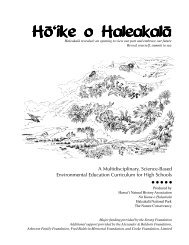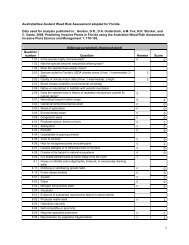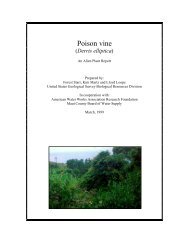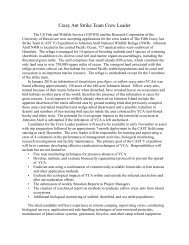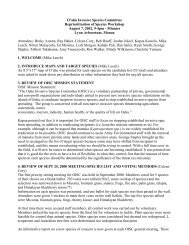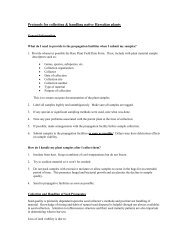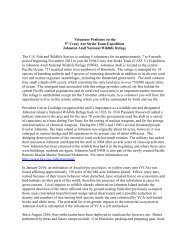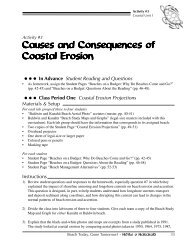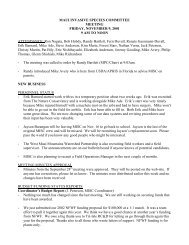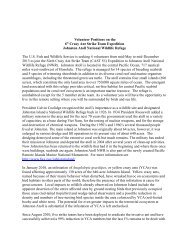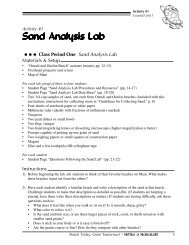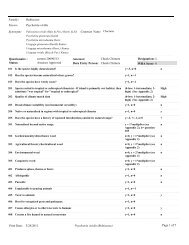Report to the Republic of Palau: 2008 update on Invasive Plant ...
Report to the Republic of Palau: 2008 update on Invasive Plant ...
Report to the Republic of Palau: 2008 update on Invasive Plant ...
Create successful ePaper yourself
Turn your PDF publications into a flip-book with our unique Google optimized e-Paper software.
species is an attractive garden plant and might be introduced this way or as tiny seeds <strong>on</strong> shoes or<br />
used equipment.<br />
O<str<strong>on</strong>g>the</str<strong>on</strong>g>r members <str<strong>on</strong>g>of</str<strong>on</strong>g> <str<strong>on</strong>g>the</str<strong>on</strong>g> family Melas<str<strong>on</strong>g>to</str<strong>on</strong>g>mataceae (including Arthrostema ciliatum (everblooming<br />
eavender), Heterocentr<strong>on</strong> subtriplinervium (pearl flower), Medinilla magnifica (chandelier tree),<br />
Medinilla venosa (holdtight), Melas<str<strong>on</strong>g>to</str<strong>on</strong>g>ma candidum (Asian melas<str<strong>on</strong>g>to</str<strong>on</strong>g>me, Indian rhododendr<strong>on</strong>,<br />
Malabar melas<str<strong>on</strong>g>to</str<strong>on</strong>g>me), Melas<str<strong>on</strong>g>to</str<strong>on</strong>g>ma sanguineum (fox-<str<strong>on</strong>g>to</str<strong>on</strong>g>ngued melas<str<strong>on</strong>g>to</str<strong>on</strong>g>ma, red melas<str<strong>on</strong>g>to</str<strong>on</strong>g>me),<br />
Memecyl<strong>on</strong> floribundum, Ossaea marginata, Oxyspora paniculata (bristletips) and Tetrazygia<br />
bicolor (Florida clover ash)) that are not native or presently in <str<strong>on</strong>g>Palau</str<strong>on</strong>g> should also be excluded.<br />
Merremia tuberosa (wood rose), a climbing, smo<str<strong>on</strong>g>the</str<strong>on</strong>g>ring vine, is notable for its aggressive<br />
behavior <strong>on</strong> Niue. It is also a problem species in Hawai‘i.<br />
Mucuna pruriens (cow itch, velvet bean) is comm<strong>on</strong>ly introduced as a cover crop and for<br />
lives<str<strong>on</strong>g>to</str<strong>on</strong>g>ck feed. It is a serious problem <strong>on</strong> Saipan and is c<strong>on</strong>sidered a weed species in Mexico,<br />
Mozambique, Jamaica and Madagascar. While <str<strong>on</strong>g>the</str<strong>on</strong>g> utilis variety comm<strong>on</strong>ly used in agriculture<br />
lacks irritating hairs it can apparently revert <str<strong>on</strong>g>to</str<strong>on</strong>g> type over time.<br />
Od<strong>on</strong><str<strong>on</strong>g>to</str<strong>on</strong>g>nema tubaeforme (fire spike, cardinal flower) is a widely cultivated ornamental that is<br />
invasive in <str<strong>on</strong>g>the</str<strong>on</strong>g> unders<str<strong>on</strong>g>to</str<strong>on</strong>g>ry <str<strong>on</strong>g>of</str<strong>on</strong>g> moist forests in American Samoa and Samoa. It primarily spreads<br />
vegetatively, but over time has managed <str<strong>on</strong>g>to</str<strong>on</strong>g> cover c<strong>on</strong>siderable area in Samoa. A related species,<br />
Od<strong>on</strong><str<strong>on</strong>g>to</str<strong>on</strong>g>nema cuspidatum, is a problem in Hawai‘i and should also be excluded (some<br />
tax<strong>on</strong>omists c<strong>on</strong>sider <str<strong>on</strong>g>the</str<strong>on</strong>g>se <str<strong>on</strong>g>the</str<strong>on</strong>g> same species).<br />
Passiflora tarminiana [formerly incorrectly known as P. mollissima in Hawai‘i] (banana poka,<br />
banana passi<strong>on</strong>fruit), a smo<str<strong>on</strong>g>the</str<strong>on</strong>g>ring vine that is a problem in Hawai‘i, is also absent. It can<br />
smo<str<strong>on</strong>g>the</str<strong>on</strong>g>r <str<strong>on</strong>g>the</str<strong>on</strong>g> forest canopy when <str<strong>on</strong>g>the</str<strong>on</strong>g> sub-canopy vegetati<strong>on</strong> is disturbed. Passiflora rubra (red<br />
passi<strong>on</strong>fruit) is very invasive in <str<strong>on</strong>g>the</str<strong>on</strong>g> Cook Islands. O<str<strong>on</strong>g>the</str<strong>on</strong>g>r Passiflora species not already present<br />
(Passiflora alata (wingstem passi<strong>on</strong>flower), Passiflora caerulea (blue passi<strong>on</strong>flower), Passiflora<br />
coccinea (scarlet passi<strong>on</strong>flower), Passiflora pulchella (two-lobed passi<strong>on</strong>flower), etc.) should<br />
also be excluded.<br />
Phyllostachys spp. and o<str<strong>on</strong>g>the</str<strong>on</strong>g>r running bamboos are apparently not present in <str<strong>on</strong>g>Palau</str<strong>on</strong>g>.<br />
Phyllostachys and similar bamboo species spread by means <str<strong>on</strong>g>of</str<strong>on</strong>g> rhizomes, as opposed <str<strong>on</strong>g>to</str<strong>on</strong>g> bamboos<br />
that grow in clumps, and are extremely difficult <str<strong>on</strong>g>to</str<strong>on</strong>g> c<strong>on</strong>trol or remove. Phyllostachys nigra<br />
(black bamboo) is a problem species in Hawai‘i while P. bissetii is extremely invasive <strong>on</strong> <str<strong>on</strong>g>the</str<strong>on</strong>g><br />
island <str<strong>on</strong>g>of</str<strong>on</strong>g> Mangaia, Cook Islands.<br />
Pimenta dioica (allspice, pimen<str<strong>on</strong>g>to</str<strong>on</strong>g>) is an invasive forest tree. The seeds are bird-dispersed. It is<br />
widespread in T<strong>on</strong>ga (‘Eua), planted in Hawai‘i (where it is naturalizing) and reported <str<strong>on</strong>g>to</str<strong>on</strong>g> be<br />
planted in French Polynesia and Fiji as well. Pimenta racemosa (bay tree), while less <str<strong>on</strong>g>of</str<strong>on</strong>g> a<br />
problem, readily naturalizes as well; for example, in <str<strong>on</strong>g>the</str<strong>on</strong>g> Cook Islands.<br />
Piper aduncum (spiked pepper) is invasive in Fiji, Papua New Guinea, <str<strong>on</strong>g>the</str<strong>on</strong>g> Solom<strong>on</strong> Islands,<br />
Ind<strong>on</strong>esia and Malaysia. Its tiny seeds are dispersed by birds and flying foxes and can be<br />
introduced in<str<strong>on</strong>g>to</str<strong>on</strong>g> new areas <strong>on</strong> machinery, particularly logging equipment. Locally, it spreads by<br />
suckers, forming large clumps.<br />
24



